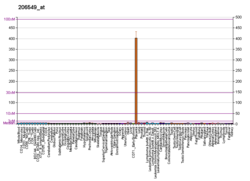| INSL4 | |||||||||||||||||||||||||||||||||||||||||||||||||||
|---|---|---|---|---|---|---|---|---|---|---|---|---|---|---|---|---|---|---|---|---|---|---|---|---|---|---|---|---|---|---|---|---|---|---|---|---|---|---|---|---|---|---|---|---|---|---|---|---|---|---|---|
| Identifiers | |||||||||||||||||||||||||||||||||||||||||||||||||||
| Aliases | INSL4 , EPIL, PLACENTIN, insulin like 4 | ||||||||||||||||||||||||||||||||||||||||||||||||||
| External IDs | OMIM: 600910; HomoloGene: 88662; GeneCards: INSL4; OMA:INSL4 - orthologs | ||||||||||||||||||||||||||||||||||||||||||||||||||
| |||||||||||||||||||||||||||||||||||||||||||||||||||
| |||||||||||||||||||||||||||||||||||||||||||||||||||
| |||||||||||||||||||||||||||||||||||||||||||||||||||
| |||||||||||||||||||||||||||||||||||||||||||||||||||
| Wikidata | |||||||||||||||||||||||||||||||||||||||||||||||||||
| |||||||||||||||||||||||||||||||||||||||||||||||||||
Early placenta insulin-like peptide is a protein that in humans is encoded by the INSL4 gene. [3] [4] [5]
INSL4 encodes the insulin-like 4 protein, a member of the insulin superfamily. INSL4 encodes a precursor that undergoes post-translational cleavage to produce 3 polypeptide chains, A-C, that form tertiary structures composed of either all three chains, or just the A and B chains. Expression of INSL4 products occurs within the early placental cytotrophoblast and syncytiotrophoblast. [5]


